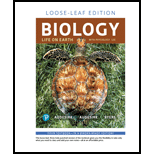
Concept explainers
Introduction:
The department of the animals under the principal taxonomical classification, which comes between the Kingdom and Class, is Phylum. There are near about ten major phyla in kingdom Animalia.
Answer to Problem 1MC
Correct answer:
The organisms in the phylum “Cnidaria” are radially symmetrical. Therefore, option (b) is correct.
Option (b) is given as “cnidarians”.
Explanation of Solution
Justify reasons for the correct statement:
The cnidarians are mostly marine animals but some also live in freshwater habitats. The characteristic feature of cnidarians is cnidoblasts “specialized cells” used for catching of prey. Some of the cnidarians are sea anemones and jellyfishes. These animals if divided along a central axis then the subparts will be equal to each other and this type of symmetry is “radial symmetry”.
Hence, option (b) is correct.
Justify reasons for the incorrect statements:
Option (a) is given as “arthropods”. The arthropods are bilateral symmetrical because they can be divided into two equal halves when cutting from the medial line. Hence, it is a wrong answer.
Option (c) is given as “mollusks”. The mollusks are bilateral symmetrical because they can be divided into two equal halves when cutting from the medial line. Hence, it is a wrong answer.
Option (d) is given as “roundworms”. The roundworms are bilateral symmetrical because they can be divided into two equal halves when cutting from the medial line. Hence, it is a wrong answer.
Hence, options (a), (c), and (d) are incorrect.
The radial symmetry is exhibited in cnidarians.
Want to see more full solutions like this?
Chapter 24 Solutions
Pearson eText Biology: Life on Earth with Physiology -- Instant Access (Pearson+)
- What symbolic and cultural behaviors are evident in the archaeological record and associated with Neandertals and anatomically modern humans in Europe beginning around 35,000 yBP (during the Upper Paleolithic)?arrow_forwardDescribe three cranial and postcranial features of Neanderthals skeletons that are likely adaptation to the cold climates of Upper Pleistocene Europe and explain how they are adaptations to a cold climate.arrow_forwardBiology Questionarrow_forward
- ✓ Details Draw a protein that is embedded in a membrane (a transmembrane protein), label the lipid bilayer and the protein. Identify the areas of the lipid bilayer that are hydrophobic and hydrophilic. Draw a membrane with two transporters: a proton pump transporter that uses ATP to generate a proton gradient, and a second transporter that moves glucose by secondary active transport (cartoon-like is ok). It will be important to show protons moving in the correct direction, and that the transporter that is powered by secondary active transport is logically related to the proton pump.arrow_forwarddrawing chemical structure of ATP. please draw in and label whats asked. Thank you.arrow_forwardOutline the negative feedback loop that allows us to maintain a healthy water concentration in our blood. You may use diagram if you wisharrow_forward
- Give examples of fat soluble and non-fat soluble hormonesarrow_forwardJust click view full document and register so you can see the whole document. how do i access this. following from the previous question; https://www.bartleby.com/questions-and-answers/hi-hi-with-this-unit-assessment-psy4406-tp4-report-assessment-material-case-stydu-ms-alecia-moore.-o/5e09906a-5101-4297-a8f7-49449b0bb5a7. on Google this image comes up and i have signed/ payed for the service and unable to access the full document. are you able to copy and past to this response. please see the screenshot from google page. unfortunality its not allowing me attch the image can you please show me the mathmetic calculation/ workout for the reult sectionarrow_forwardIn tabular form, differentiate between reversible and irreversible cell injury.arrow_forward

 Concepts of BiologyBiologyISBN:9781938168116Author:Samantha Fowler, Rebecca Roush, James WisePublisher:OpenStax College
Concepts of BiologyBiologyISBN:9781938168116Author:Samantha Fowler, Rebecca Roush, James WisePublisher:OpenStax College Biology: The Dynamic Science (MindTap Course List)BiologyISBN:9781305389892Author:Peter J. Russell, Paul E. Hertz, Beverly McMillanPublisher:Cengage Learning
Biology: The Dynamic Science (MindTap Course List)BiologyISBN:9781305389892Author:Peter J. Russell, Paul E. Hertz, Beverly McMillanPublisher:Cengage Learning Biology (MindTap Course List)BiologyISBN:9781337392938Author:Eldra Solomon, Charles Martin, Diana W. Martin, Linda R. BergPublisher:Cengage Learning
Biology (MindTap Course List)BiologyISBN:9781337392938Author:Eldra Solomon, Charles Martin, Diana W. Martin, Linda R. BergPublisher:Cengage Learning Biology 2eBiologyISBN:9781947172517Author:Matthew Douglas, Jung Choi, Mary Ann ClarkPublisher:OpenStax
Biology 2eBiologyISBN:9781947172517Author:Matthew Douglas, Jung Choi, Mary Ann ClarkPublisher:OpenStax





